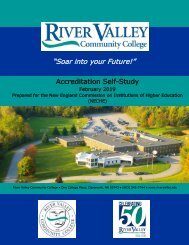You also want an ePaper? Increase the reach of your titles
YUMPU automatically turns print PDFs into web optimized ePapers that Google loves.
levels of the taxonomy, while courses later in the programs have objectives that assess<br />
higher levels of the taxonomy. Ultimately, the objectives of each course build on one<br />
another in order to progress the student toward meeting the programmatic outcomes.<br />
Assessment of learning occurs mostly at the course level and is the responsibility of the<br />
faculty teaching each course as overseen by the Program Directors. The course outlines<br />
identify expected types of assessment methods for each course. Assessment at <strong>RVCC</strong><br />
includes traditional methods such as quizzes, tests, projects, laboratory practical exams,<br />
projects, portfolios, and presentations. Assessment methods are designed to meet the<br />
type of outcome; for example, tests and quizzes are utilized to measure knowledge<br />
outcomes, while practical exams are often used to measure psychomotor skills.<br />
One example of assessment at the course level occurred in Phlebotomy (PHBC 110R),<br />
which had a traditional rate of approximately 50% success, meaning only half of all<br />
students who started the course were successful enough (passing with a C or better) to<br />
move onto the second half of the certificate, the Phlebotomy Internship (PHBC190R). This<br />
data remained consistent regardless of instructor, variability in teaching, or variability in<br />
testing methods. In March of 2017, the Department Chair of Health Science, after<br />
consultation with the adjunct faculty at the time, put forth a curriculum change to add a<br />
formal lab component to the course. The course was originally a 3 credit lecture course<br />
with a primary focus on theory. While psychomotor skills were taught and tested, the<br />
format of the course did not allow for enough seat time for students to practice and perfect<br />
technique. In March of 2017 the course was changed to a lecture/lab course with students<br />
spending 2 hours of lecture (2 credits) and 2 hours of lab (1 credit) each week in class.<br />
This increased the psychomotor practice time without increasing credit load to the<br />
students. Simultaneously, the Phlebotomy program went through the Perkins grant to<br />
obtain two new practice draw arms which were put in place in the course in Fall of 2018.<br />
The restructuring of the course, and the obtainment of new teaching tools, lead to an<br />
increased success rate of students completing PHBC 110R and being eligible to continue on<br />
to PHBC 190R. In Fall of 2018, 89.5% of students taking PHBC 110R passed with a C or<br />
better and were eligible to take the Phlebotomy Internship.<br />
Another unique assessment method that occurs at the College is in the Anatomy &<br />
Physiology (A&P) courses to ensure student learning is the use of common exams and<br />
common case studies. All students, regardless of the course section they are taking, or<br />
the instructor they are taking A&P I or II with, have the same exams and also complete<br />
the same final case study. By having a common exam and case study, the Program<br />
Director of Biological Sciences has a way to measure student learning across the program<br />
as well as has data that assists with looking at teaching effectiveness. The Program<br />
Director looks at the average scores and score distribution for each section of the course to<br />
see if there are significant differences in content knowledge and grades. She also<br />
compares scores on final case studies and exams to previous semesters. There have not<br />
been any significant differences to note on the final case studies; but in one instance, the<br />
Program Director saw that in one section of A&P II, students were scoring far lower on<br />
their exams than students in other sections. The Program Director met with the faculty<br />
and realized that the instructor was not using the study guides and was not giving<br />
homework assignments. The Program Director began monitoring the faculty more closely<br />
124 | P a g e





